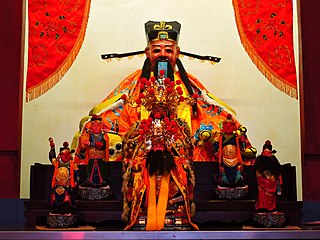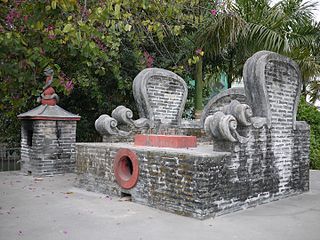Footnotes
- ↑ Ma & Cartier (2003) , pp. 166–167
- 1 2 Jordan, Morris & Moskowitz (2004) , p. 44
- ↑ Jordan, Morris & Moskowitz (2004) , p. 45
- ↑ Katz (2009) , p. 75
- ↑ Katz (2009) , pp. 76–77
- ↑ Overmyer (2003) , pp. 102–103
- 1 2 Katz (2009) , p. 74
- 1 2 Jordan, Morris & Moskowitz (2004) , pp. 38–39
- ↑ Jordan, Morris & Moskowitz (2004) , p. 39
- ↑ Katz (2009) , pp. 75–77
- ↑ De Groot (1964) , pp. 200–203
- ↑ Overmyer (2003) , p. 102
- ↑ Overmyer (2003) , p. 16
Related Research Articles

Religion in China is diverse and most Chinese people are either non-religious or practice a combination of Buddhism and Taoism with a Confucian worldview, which is collectively termed as Chinese folk religion.

The Chenghuangshen, is a tutelary deity or deities in Chinese folk religion who is believed to protect the people and the affairs of the particular village, town or city of great dimension, and the corresponding afterlife location.

Chinese folk religion, also known as Chinese popular religion, comprehends a range of traditional religious practices of Han Chinese, including the Chinese diaspora. Vivienne Wee described it as "an empty bowl, which can variously be filled with the contents of institutionalised religions such as Buddhism, Taoism, Confucianism and Chinese syncretic religions". This includes the veneration of shen (spirits) and ancestors. Worship is devoted to deities and immortals, who can be deities of places or natural phenomena, of human behaviour, or founders of family lineages. Stories of these gods are collected into the body of Chinese mythology. By the Song dynasty (960–1279), these practices had been blended with Buddhist, Confucian, and Taoist teachings to form the popular religious system which has lasted in many ways until the present day. The present day government of mainland China, like the imperial dynasties, tolerates popular religious organizations if they bolster social stability but suppresses or persecutes those that they fear would undermine it.

A Tudigong is a kind of Chinese tutelary deity of a specific location. There are several Tudigongs corresponding to different geographical locations and sometimes multiple ones will be venerated together in certain regions.

Hittite mythology and Hittite religion were the religious beliefs and practices of the Hittites, who created an empire centered in what is now Turkey from c. 1600–1180 BC.

Religion in Taiwan is characterised by a diversity of religious beliefs and practices, predominantly those pertaining to the continued preservation of the ancient Chinese culture and religion. Freedom of religion is inscribed in the constitution of the Republic of China (Taiwan). The majority of Taiwanese people practice a combination of Buddhism and Taoism often with a Confucian worldview, which is collectively termed as Chinese folk religion.

Fuji is a Chinese automatic writing method that uses a suspended sieve or tray called a planchette to guide a stick writing Chinese characters, either in sand or the ashes of incense.

Chinese ancestor veneration, also called Chinese ancestor worship, is an aspect of the Chinese traditional religion which revolves around the ritual celebration of the deified ancestors and tutelary deities of people with the same surname organised into lineage societies in ancestral shrines. Ancestors, their ghosts, or spirits, and gods are considered part of "this world". They are neither supernatural nor transcendent in the sense of being beyond nature. The ancestors are humans who have become godly beings, beings who keep their individual identities. For this reason, Chinese religion is founded on veneration of ancestors. Ancestors are believed to be a means of connection to the supreme power of Tian as they are considered embodiments or reproducers of the creative order of Heaven. It is a major aspect of Han Chinese religion, but the custom has also spread to ethnic minority groups.

Wang Ye worship is a Fujianese and Taiwanese folk religion, frequently considered an aspect of the Taoist belief system. Wang Ye is particularly worshipped in Southern Taiwan and also among Minnan speaking communities worldwide.

Xiaochi is an important category of Chinese street food, commonly found in Chinese populated communities around the world. Xiaochi are substantial snacks, which can be eaten together or with more substantial dishes like the Spanish tapas or Middle Eastern Levantine meze, or alone as a light meal or snack like the French goûter.

Chinese ritual mastery traditions, also referred to as ritual teachings, Folk Taoism, or Red Taoism, constitute a large group of Chinese orders of ritual officers who operate within the Chinese folk religion but outside the institutions of official Taoism. The "masters of rites", the fashi (法師), are also known in east China as hongtou daoshi (紅頭道士), meaning "redhead" or "redhat" daoshi, contrasting with the wutou daoshi (烏頭道士), "blackhead" or "blackhat" priests, of Zhengyi Taoism who were historically ordained by the Celestial Master.

Nuo folk religion, or extendedly, Chinese popular exorcistic religion, is a variant of Chinese folk religion with its own system of temples, rituals, orders of priests, and gods that is interethnic and practiced across central and southern China but is also intimately connected to the Tujia people. It arose as an exorcistic religious movement, which is the original meaning of nuó. It has strong influences from Taoism.

Chinese gods and immortals are beings in various Chinese religions seen in a variety of ways and mythological contexts.
Daniel L. Overmyer was a Canadian historian of religion and academic who was Professor Emeritus in the Department of Asian Studies and the Centre for Chinese Research at the University of British Columbia. Overmyer was a pioneer in the study of Chinese popular thought, religion, and culture; popular religious sects of the late traditional and modern periods and their texts; and local rituals and beliefs practiced in villages, especially North China.

The Tianfei Palace, officially the Mazu Cultural Palace and also known as the Tianhou Palace, is a restored temple of the Chinese sea-goddess Mazu, the deified form of the medieval Fujianese shamaness Lin Moniang, located in Fangta Park in Songjiang, Shanghai, in eastern China. Officially classified as a museum, the Tianfei Palace conducts Mazuist rites twice a year, on the traditional anniversaries of Lin Moniang's birth and death. It is also used as the site for an annual commemoration of Songjiang's city god Li Daiwen.
Weixinism, institutionally also known by the extended title of Holy Church of the Heart-Only is one of the Chinese salvationist religions born in Taiwan in the late 20th century. It was founded in 1984 in Taichung by Grand Master Hun Yuan. Its global core membership is about 300,000, with a larger audience estimated by Taiwan's Ministry of Internal Affairs at 1,000,000. The church has quickly spread to mainland China since the early 2000s, where it functions as a platform for joint initiatives of the Chinese mainland and Taiwanese governments for the renewal of Chinese culture. It has also developed as a worldwide religious movement, attracting followers not only from the Chinese diaspora, but also communities of other races, including East Asians and even Westerners.
A Joss is an English term used to refer to a Chinese deity or idol. It generally describes a Chinese religious statue, object, or idol in many Chinese folk religions.

Qiongxiao Xianzi, also known as Zhao Qiongxiao, is a character in the classic 16th-century Chinese novel Fengshen Yanyi. She is worshipped as a goddess of childbirth in Chinese folk religion. She is one of the Sanxiao Shengmu or Sanxiao Niangniang.

Bixiao Xianzi, also known as Zhao Bixiao, is a character in the classic 16th-century Chinese novel Fengshen Yanyi. She is worshipped as a goddess of childbirth in Chinese folk religion. She is one of the Sanxiao Shengmu or Sanxiao Niangniang.
Forms of religion in China throughout history have included animism during the Xia dynasty, which evolved into the state religion of the Shang and Zhou. Alongside an ever-present undercurrent of Chinese folk religion, highly literary, systematised currents related to Taoism and Confucianism emerged during the Spring and Autumn period. Buddhism began to influence China during the Han dynasty, and Christianity and Islam appeared during the Tang.
References
- Overmyer, D. L., ed. (2003). Religion in China Today. The China Quarterly Special Issues New Series. Vol. 3. Cambridge: Cambridge University Press.
- De Groot, J. M. G. (1964). The Religious System of China: its ancient forms, evolution, history and present aspect, manners, customs and social institutions connected therewith. Vol. I. Amsterdam: Literature House. ISBN 1314345567.
- Jordan, D. K.; Morris, A. D.; Moskowitz, M. L., eds. (2004). The Minor Arts of Daily Life: Popular Culture in Taiwan. Hawai’i: University of Hawai’i Press. ISBN 0824828003.
- Ma, Laurence J. C.; Cartier, Carolyn L. (2003). The Chinese Diaspora: Space, Place, Mobility and Identity. Maryland: Rowman & Littlefield. ISBN 074251756X.
- Katz, P. R. (2009). Divine Justice: Religion and the Development of Chinese Legal Culture. New York: Academia Sinica. ISBN 978-0415574334.